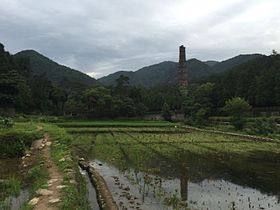Tiantai Mountain
| Tiantai Mountain | |
|---|---|

A view of Tiantai Mountain and the Guoqing Temple Ancient Tower, constructed during the Sui Dynasty.
|
|
| Highest point | |
| Elevation | 1,138 m (3,734 ft) |
| Coordinates | 29°10′44″N 121°02′32″E / 29.178843°N 121.042213°E |
| Geography | |
| Location | Zhejiang, China |
| Tiantai Shan | |||||||||||||||||||||
| Chinese | 天台山 | ||||||||||||||||||||
|---|---|---|---|---|---|---|---|---|---|---|---|---|---|---|---|---|---|---|---|---|---|
| Hanyu Pinyin |
PRC Standard Mandarin: Tiāntāi Shān ROC Standard Mandarin: Tiāntái Shān |
||||||||||||||||||||
|
|||||||||||||||||||||
| Transcriptions | |
|---|---|
| Standard Mandarin | |
| Hanyu Pinyin |
PRC Standard Mandarin: Tiāntāi Shān ROC Standard Mandarin: Tiāntái Shān |
| Bopomofo |
PRC: ㄊㄧㄢ ㄊㄞ ㄕㄢ ROC: ㄊㄧㄢ ㄊㄞˊ ㄕㄢ |
| Gwoyeu Romatzyh |
PRC: Tiantai Shan ROC: Tiantair Shan |
| Wade–Giles |
PRC: T‘ien1-t‘ai1 Shan1 ROC: T‘ien1-t‘ai2 Shan1 |
| Tongyong Pinyin |
PRC: Tiantai Shan ROC: Tiantái Shan |
| Yale Romanization |
PRC: Tyāntāi Shān ROC: Tyāntái Shān |
| MPS2 |
PRC: Tiāntāi Shān ROC: Tiāntái Shān |
| IPA |
PRC: [tʰjɛ́n.tʰái ʂán] ROC: [tʰjɛ́n.tʰǎi ʂán] |
Tiantai Mountain, Mount Tiantai, or Tiantai Shan is a mountain in Tiantai County near the city of Taizhou, Zhejiang, China. Its highest peak, Huading, reaches a height of 1,138 meters (3,734 ft). The mountain was made a national park on 1 August 1988. One of nine remaining wild populations of Seven-Son Flower Heptacodium miconioides is located on Mount Tiantai.
In Chinese mythology, the creator goddess Nüwa cut the legs off a giant sea turtle (Chinese: 鳌; pinyin: áo) and used them to prop up the sky after Gong Gong damaged Mount Buzhou, which had previously supported the heavens. A local myth holds that Mount Tiantai was on the turtle's back before and Nüwa relocated it to its current position when she had to remove the turtle's legs.
Guoqing Temple on the mountain is the headquarters of Tiantai Buddhism and also a tourist destination. Tiantai, named for the mountain, focuses on the Lotus Sutra. The most prominent teacher of that school, Zhiyi, was based at Guoqing Temple. Over many years it has been an important destination for pilgrims, especially from Japan. The mountain was visited by Saichō in 805 who went on to found the related Japanese Buddhist school, Tendai.
The mountain has a famous temple to the Song-era monk Ji Gong at the Cave of Auspicious Mists that was associated with early modern fuji or "spirit writing" movements.
...
Wikipedia
